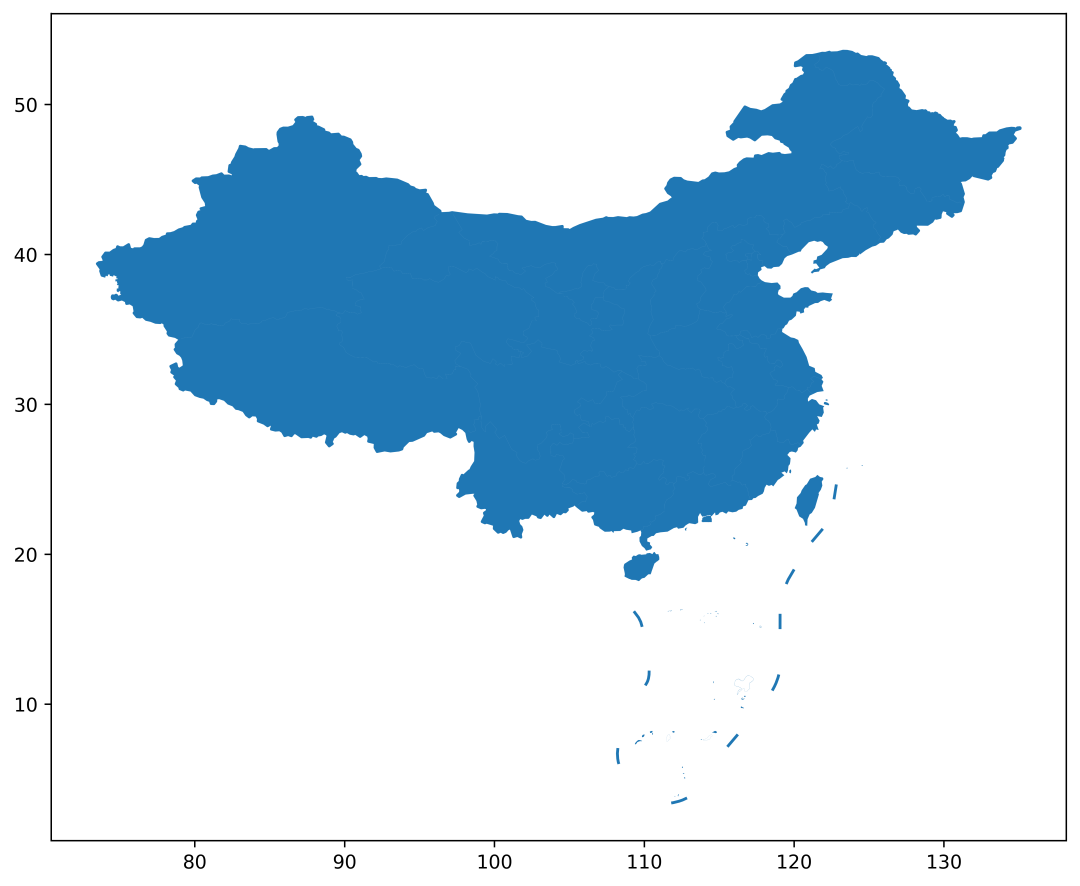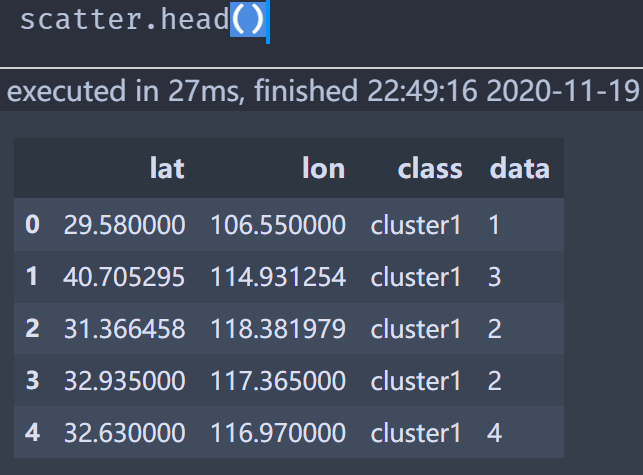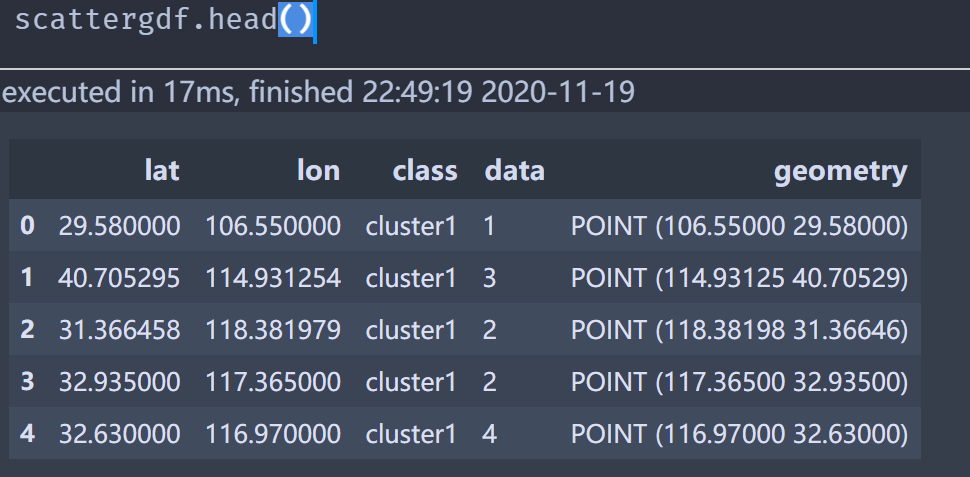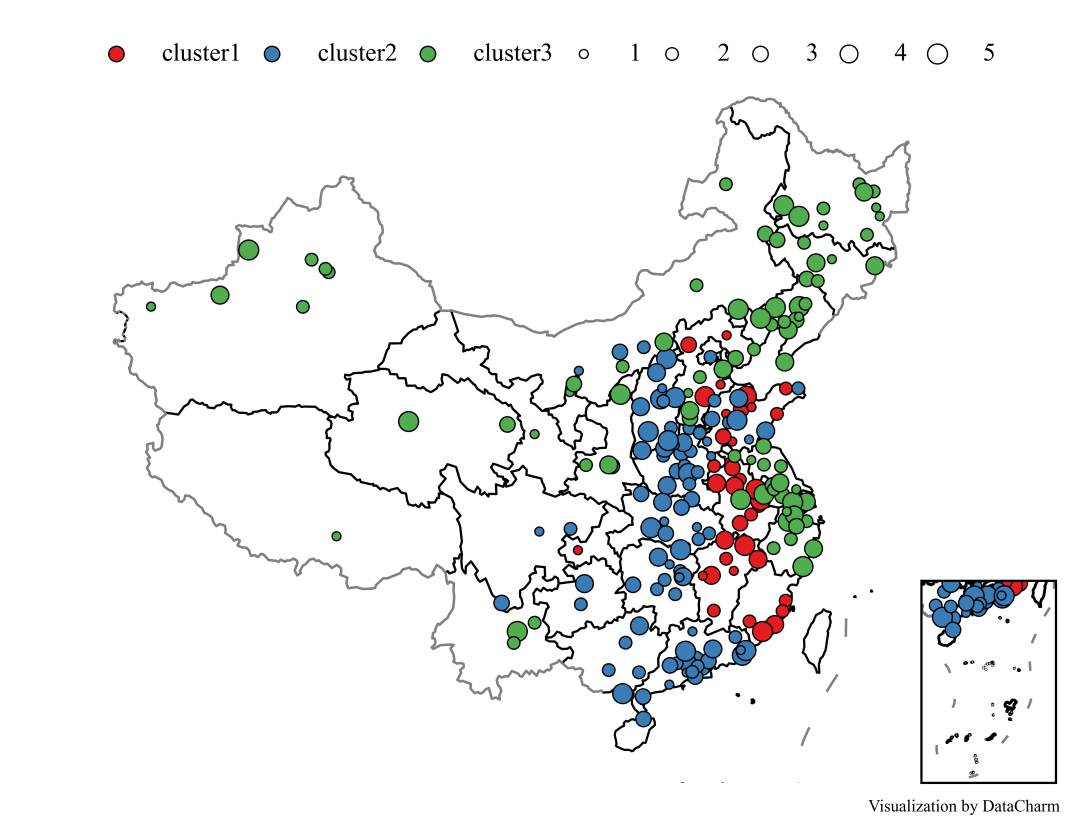Python-geopandas 中国地图绘制
击上方“Python爬虫与数据挖掘”,进行关注
回复“书籍”即可获赠Python从入门到进阶共10本电子书
上一期的地图可视化推文教程R-ggplot2 标准中国地图制作中,我们详细介绍了使用R-ggplot2 包完美绘制中国标准地图,本期推文我们则试着使用Python-geopandas包绘制空间地图,主要的知识点如下:
geopandas 绘制中国地图 matplotlib add_axes()添加南海小地图 绘图文件分享
geopandas 读取中国地图文件
geopandas提供了非常方便的read_file()方法用于读取geojson文件,我们直接进行默认投影(WGS84)的绘制,代码如下:
file = r"中国省级地图GS(2019)1719号.geojson"
nine = r"九段线GS(2019)1719号.geojson"
china_main = gpd.read_file(file)
china_nine = gpd.read_file(nine)
fig, ax = plt.subplots(figsize=(12, 8),dpi=80)
ax = china_main.plot(ax=ax)
ax = china_nine.plot(ax=ax)
可视化结果如下:
我们进行投影转换(epsg=2343)和进行一些简单的设置,代码如下:
fig, ax = plt.subplots(figsize=(12, 8),dpi=80)
ax = china_main.geometry.to_crs(epsg=2343).plot(fc="white",ec="black",ax=ax)
ax = china_nine.geometry.to_crs(epsg=2343).plot(ec="black",ax=ax)
这里注意to_crs(epsg=2343) 就可以进行投影转换了。
绘图数据操作
接下来,我们将我们要绘制的数据读取、转换并绘制在地图上,数据预览如下:
我们使用如下代码将其转换成具有地理信息的geopandas 格式数据:
scattergdf = gpd.GeoDataFrame(
scatter, geometry=gpd.points_from_xy(scatter.lon, scatter.lat),
crs="EPSG:4326")
scattergdf.head()
结果如下:
接下来再将其转换成 epsg=2343 投影下的数据:
scattergdf_2343 = scattergdf.to_crs(epsg=2343, inplace=True)
以上就完成的数据的处理操作了
地图可视化绘制
直接给出绘图代码,然后再进行解释。主要代码如下:
fig, ax = plt.subplots(figsize=(8,5),dpi=200,)
plt.rcParams['font.family'] = ['Times New Roman']
ax = china_main.geometry.to_crs(epsg=2343).plot(fc="white",ec="black",linewidth=.8,ax=ax)
ax = china_nine.geometry.to_crs(epsg=2343).plot(color="gray",linewidth=.9,ax=ax)
for loc, size,class_name in zip(scattergdf_2343.geometry.representative_point(),\
scattergdf_2343["data"],scattergdf_2343["class"]):
ax.scatter(loc.x,loc.y,s=10*size,fc=class_color[class_name],ec="black",lw=.5,zorder=2)
#添加刻度线
for spine in ['top','left',"bottom","right"]:
ax.spines[spine].set_color("none")
ax.set_xlim(china_nine_2343.geometry[0].x-500000, china_nine_2343.geometry[1].x)
ax.set_ylim(china_nine_2343.geometry[0].y, china_nine_2343.geometry[1].y)
ax.set_xticks([])
ax.set_yticks([])
#单独绘制图例散点
ax.scatter([], [], c='#E21C21', s=30, label='cluster1',ec="black",lw=.5)
ax.scatter([], [], c='#3A7CB5', s=30, label='cluster2',ec="black",lw=.5)
ax.scatter([], [], c='#51AE4F', s=30, label='cluster3',ec="black",lw=.5)
ax.scatter([], [], c='white', s=1*10,label='1', edgecolor='black',lw=.5)
ax.scatter([], [], c='white', s=2*10,label='2', edgecolor='black',lw=.5)
ax.scatter([], [], c='white', s=3*10,label='3', edgecolor='black',lw=.5)
ax.scatter([], [], c='white', s=4*10,label='4', edgecolor='black',lw=.5)
ax.scatter([], [], c='white', s=5*10,label='5', edgecolor='black',lw=.5)
ax.legend(frameon=False,ncol=8,loc="upper center",
fontsize=9,columnspacing=.2)
ax.text(.91,-0.02,'\nVisualization by DataCharm',transform = ax.transAxes,
ha='center', va='center',fontsize = 6,color='black')
#添加南海小地图
ax_child = fig.add_axes([0.688, 0.125, 0.2, 0.2])
ax_child = china_main.geometry.to_crs(epsg=2343).plot(ax=ax_child,
fc="white",
ec="black",)
ax_child = china_nine.geometry.to_crs(epsg=2343).plot(ax=ax_child,
color="gray",
linewidth=.9,
)
for loc, size,class_name in zip(scattergdf_2343.geometry.representative_point(),\
scattergdf_2343["data"],scattergdf_2343["class"]):
ax_child.scatter(loc.x,loc.y,s=10*size,fc=class_color[class_name],ec="black",lw=.5,zorder=2)
ax_child.set_xlim(china_nine_2343.geometry[2].x, china_nine_2343.geometry[3].x)
ax_child.set_ylim(china_nine_2343.geometry[2].y, china_nine_2343.geometry[3].y)
# 移除子图坐标轴刻度,
ax_child.set_xticks([])
ax_child.set_yticks([])
add_axes() 添加南海小地图
#添加南海小地图
ax_child = fig.add_axes([0.688, 0.125, 0.2, 0.2])
ax_child = china_main.geometry.to_crs(epsg=2343).plot(ax=ax_child,
fc="white",
ec="black",)
ax_child = china_nine.geometry.to_crs(epsg=2343).plot(ax=ax_child,
color="gray",
linewidth=.9,
)
for loc, size,class_name in zip(scattergdf_2343.geometry.representative_point(),\
scattergdf_2343["data"],scattergdf_2343["class"]):
ax_child.scatter(loc.x,loc.y,s=10*size,fc=class_color[class_name],ec="black",lw=.5,zorder=2)
ax_child.set_xlim(china_nine_2343.geometry[2].x, china_nine_2343.geometry[3].x)
ax_child.set_ylim(china_nine_2343.geometry[2].y, china_nine_2343.geometry[3].y)
# 移除子图坐标轴刻度,
ax_child.set_xticks([])
ax_child.set_yticks([])
可以发现,除了显示范围的不同外,其他的和绘制主题部分的代码一致。
单独添加图例
#单独绘制图例散点
ax.scatter([], [], c='#E21C21', s=30, label='cluster1',ec="black",lw=.5)
ax.scatter([], [], c='#3A7CB5', s=30, label='cluster2',ec="black",lw=.5)
ax.scatter([], [], c='#51AE4F', s=30, label='cluster3',ec="black",lw=.5)
ax.scatter([], [], c='white', s=1*10,label='1', edgecolor='black',lw=.5)
ax.scatter([], [], c='white', s=2*10,label='2', edgecolor='black',lw=.5)
ax.scatter([], [], c='white', s=3*10,label='3', edgecolor='black',lw=.5)
ax.scatter([], [], c='white', s=4*10,label='4', edgecolor='black',lw=.5)
ax.scatter([], [], c='white', s=5*10,label='5', edgecolor='black',lw=.5)
ax.legend(frameon=False,ncol=8,loc="upper center",
fontsize=9,columnspacing=.2)
这部分还是为了更好的定制化图例,希望大家可以掌握。
最终,我们的可视化效果如下:
注:该数据只限于练习交流,请勿用于科研、出版使用。
总结
本期推文使用了Python-geopandas进行了中国地图的绘制,讲解了数据标记,投影转换等内容。但需指出的是:
geopandas 的安装较为麻烦,建议使用 conda install --channel conda-forge geopandas 进行安装。 Python 绘制空间可视化还是存在部分问题(无法较容易的添加如比例尺、指北针等空间绘图元素),也在进一步完善过程中。
------------------- End -------------------
往期精彩文章推荐:

欢迎大家点赞,留言,转发,转载,感谢大家的相伴与支持
想加入Python学习群请在后台回复【入群】
万水千山总是情,点个【在看】行不行
/今日留言主题/
随便说一两句吧~~
评论
